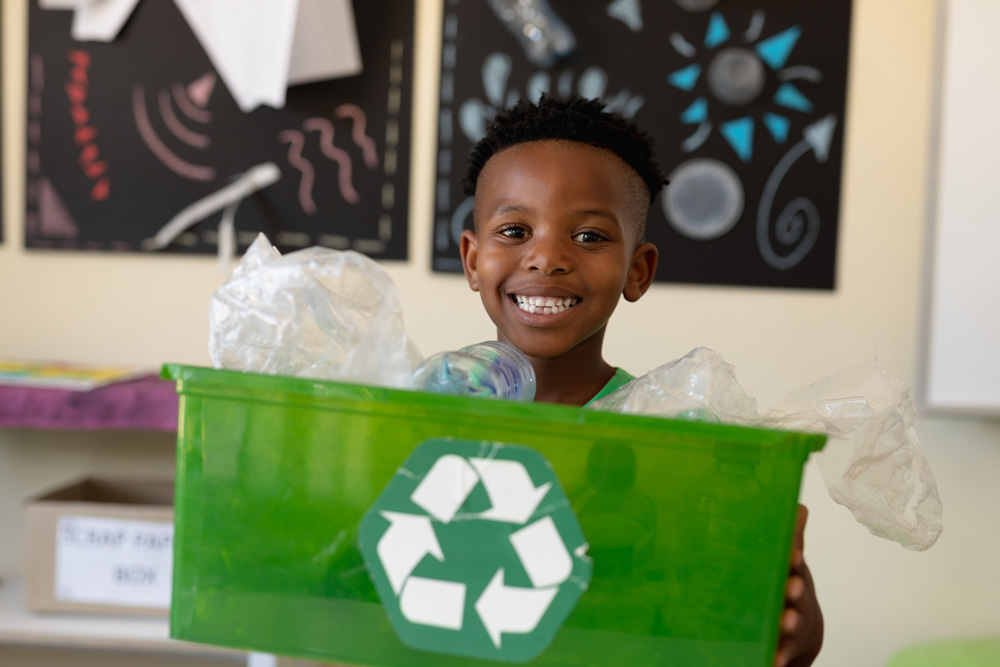Who’s Responsible for Africa’s Digital Dumps?

In parts of Africa, discarded electronics are turning streets and open lots into toxic wastelands. Old TVs, phones, laptops, and computers—exported under the guise of ‘reuse and repair’ often arrive as irreparable junk. Destined to be burned or abandoned, they release harmful chemicals that create severe health and environmental risks for communities already struggling with limited resources.
Africa’s digital dumps are fueled mainly by shipments from developed nations and reveal an unsettling truth: what’s labeled as recycling often masks a dangerous and exploitative practice.
While we can turn tech trash into treasure, local markets in places like Lagos, Nigeria, report that up to 75% of imported electronics are unusable. This toxic influx highlights a system that prioritizes profit over responsibility, leaving vulnerable communities to bear the consequences.
Globally, 53.6 million metric tons of e-waste were generated in 2019, with only 17% recycled appropriately. This e-waste crisis forces us to rethink the life cycle of technology. How did we reach this point, and who is responsible for cleaning up this mess? Stick with us as we look into the issue.
The Toxic Truth Behind E-Waste Recycling in Africa

E-waste in Africa originates from imports

E-waste generation by country in Africa

E-waste recycling in Africa

The largest E-waste processing site in Africa
In the bustling markets of Ghana, Accra, and other parts of Africa, discarded electronics have created a bittersweet economy. On one hand, recycling and refurbishing e-waste have provided jobs and incomes for tens of thousands of people.
In Ghana alone, over 40,000 workers are now engaged in recycling operations. Workers dismantle old devices to extract valuable materials like gold, copper, and iron. This informal sector supports entire communities, with estimates suggesting that over 200,000 Ghanaians indirectly rely on e-waste recycling to make ends meet.
But there’s a darker side to it. Improper recycling methods release toxic substances such as mercury, brominated flame retardants, and heavy metals into the environment. These pollutants contaminate the soil, water, and air, putting everyone at risk including the workers and surrounding communities.
Studies on the health consequences of e-waste have linked exposure to severe health issues, including developmental problems in children, impaired neurological functions, and increased risks of chronic diseases.
Children, some as young as five, are often seen in these informal recycling areas, sorting through piles of waste and handling harmful substances with no protective equipment. Since their developing bodies are particularly vulnerable, they are more susceptible to long-term health complications.
While the e-waste sector provides critical income, the balance between livelihoods and safety is dangerously skewed. Without stricter regulations and safer recycling solutions, the very industry that sustains so many may ultimately harm the lives it seeks to support.
But who’s responsible for Africa’s digital dumps? That’s a question the world can no longer afford to ignore.
Where Does the Digital Dump in Africa Come From?
Africa’s e-waste problem isn’t homegrown alone. It comes from three sources: local production, imported electronics, and outright dumping by wealthier nations.
Let’s break it down.
E-Waste from Local Production

E-waste generation in Africa
Electronics manufacturing is booming in Africa, with countries like Egypt, Nigeria, and South Africa leading the charge. In 2019, Africa produced 2.9 million metric tons of e-waste, yet most countries lack formal recycling systems.
With electronic waste often tossed alongside municipal trash, landfills have become scavenging grounds where discarded devices are picked apart for valuable components. This chaotic system leaves much to be desired in terms of efficiency and environmental safety.
The Trap of Imported Used Electronics
Second-hand electronics, often labeled as "usable" or "repairable," are pouring into Africa under the form of affordability. The truth? More than half of these imports are beyond repair, bound to become junk.

Irreparable donated electronics in Kenya
In Kenya, for instance, 60% of donated electronics to schools were found to be irreparable. Hidden within shipments of sewing machines or bicycles, these devices often come from countries like China, the U.S., Spain, and the UK. In 2015 and 2016, approximately 60,000 tons of used electronics were shipped into Nigeria this way. Once they land, they fuel the ever-growing piles of e-waste across the continent.
Exported Waste for Disposal
Some high-income countries take a more immodest approach. They outright ship their e-waste to low-income countries in Africa for disposal. With minimal regulations and enforcement, these shipments become toxic burdens for communities.

Image Source: iStock/Wavebreakmedia
Informal recycling operations—often in backyards or near homes—expose untrained workers and children to harmful materials like mercury and lead. Open dumpsites become hubs of hazardous scavenging, with little regard for health or safety.
Which Countries Are Affected by E-Waste the Most?
Africa’s growing e-waste problem is especially severe in countries like Ghana, Nigeria, and Egypt. These nations are facing an influx of electronic trash from both local sources and global dumping.
Ghana’s Agbogbloshie, often dubbed the world’s largest e-waste dump, processes around 250,000 tons of e-waste annually. The toxic burning practices here poison the air, soil, and water. Shockingly, one egg from the area has brominated dioxin levels 220 times above European safety limits.
Nigeria’s smaller sites, like Lagos’s Alaba Market, face similar dangers. Burning plastic and acid-leaching circuit boards release hazardous chemicals. Meanwhile, countries like Egypt, despite leading in local e-waste generation, lack proper recycling infrastructure or legislation, making the crisis even harder to manage.
The story is similar across the continent, from soil contamination in Cameroon to unregulated burning in South Africa. The absence of robust policies and enforcement leaves communities vulnerable to pollution and health hazards. This growing crisis calls for urgent, coordinated action, with liable policies leading the way.
Why Do African Countries Take in E-Waste?
If you’re like us, you’re right to question why African countries accept e-waste from other countries when the consequences are hazardous.
E-waste, while hazardous, can also be a goldmine. Many African countries, though dealing with the heavy environmental and health toll of e-waste, also see it as a chance to earn. With components like copper, gold, and plastics hidden inside discarded electronics, the trade and recycling of e-waste provide jobs and a means of survival.
Here’s what drives the acceptance of this harmful waste.
The Economic Opportunity

Raw material recovered from E-waste in Africa
The value of e-waste is undeniable. In 2019, raw materials recovered from e-waste in Africa were worth $3.2 billion. This has sparked a bustling informal economy where recycling and repair provide essential livelihoods for thousands of people.
Ghana’s Agbogbloshie offers direct jobs to over 4,500 people and indirect work for many more. While this brings much-needed cash to many, it also exposes workers to serious risks. Despite these dangers, the economic incentives keep the e-waste industry alive and kicking.
Weak Regulations for E-Waste Management
One of the main reasons African countries accept e-waste is the lack of strong, enforceable regulations. Though some nations have laws, like those in West Africa, they are often poorly enforced. This creates a situation where illegal e-waste importation thrives.
In countries where e-waste laws are nonexistent or weak, like in parts of Southern and Northern Africa, toxic materials enter the waste stream unchecked. Without proper oversight, the informal sector is left to handle these hazardous materials, which increases the risks to affected communities.
Non-Existent Interventions
The need for better solutions is clear. Fortunately, many efforts are underway to clean up the mess and make e-waste recycling safer. For example, organizations like Pure Earth in Ghana are working to improve working conditions at e-waste sites like Agbogbloshie by introducing safer recycling methods.
However, despite these initiatives, the challenge remains significant. The economic reliance on e-waste makes it difficult to transition away from toxic methods, like burning cables for copper. There’s a pressing need for better models that balance economic interests with health and environmental safety.
International Agreements and Local Initiatives
Conventions like the Basel Convention and the Bamako Convention work to prevent the illegal movement of hazardous waste to Africa on the global stage. However, these treaties often struggle to make a tangible difference on the ground. Local interventions are making headway, but they must be strengthened.
For example, South Africa’s e-Waste Association (eWASA) works on promoting sustainable e-waste management, though it faces hurdles due to the country’s reliance on the e-waste trade. International support and local buy-in will be crucial in addressing the broader e-waste problem.
How Africa Is Dealing with E-Waste?
Africa is taking bold steps to tackle its mounting e-waste crisis by balancing environmental responsibility with economic realities. While challenges remain, governments, businesses, and communities work together to create more sustainable systems.
Some key strategies being implemented include:
1. Clearly Defining Stakeholders in the Value Chain
One of the first steps is clarifying who is responsible for e-waste management. Many African nations, such as Côte d’Ivoire, Ghana, Nigeria, and South Africa, have established regulations that define "producers" of electronics, including importers, manufacturers, and distributors. This clear definition makes it easier to assign responsibility for managing electronic waste.
Through Extended Producer Responsibility (EPR) schemes, these stakeholders must handle the end-of-life processing of their products, such as recycling and safe disposal.
2. Ensuring Sustainable Financing for E-Waste Management
A self-financing system is crucial for long-term success, and African countries are exploring innovative funding models. In Nigeria, producers contribute to e-waste management costs by paying fees to the E-Waste Producer Responsibility Organisation Nigeria, a not-for-profit organization.
Similarly, Ghana has introduced an eco-levy on imported electronics to ensure sustainable financing for waste management. These efforts secure funding and help raise awareness about the importance of proper e-waste disposal.
3. Partnering With the Private Sector
Public-private partnerships are playing a massive role in addressing the e-waste challenge. Rwanda, for instance, has collaborated with Enviroserve, a large recycling company, to establish a national e-waste recycling program.
South Africa has also embraced Producer Responsibility Organizations (PROs) to help industries fulfill their obligations under EPR schemes. These partnerships bring expertise, funding, and scalability to national e-waste management efforts.
4. Strengthening Enforcement Mechanisms
To ensure compliance, countries like Zambia enforce stricter regulations on imported electronics. The Zambia Information and Communications Technologies Authority (ZICTA) works with the Zambia Revenue Authority to approve technology imports and monitor their quality.
By tracking imports and enforcing technical standards, Zambia reduces the likelihood of counterfeit or substandard electronics, which often become e-waste more quickly.
What’s the Way Forward?
Africa’s e-waste problem is a pressing global issue that reflects our collective habits in producing, consuming, and discarding electronics. The solutions demand accountability at every level.
Manufacturers need to design products that last longer and are easier to recycle. Governments should enforce regulations, and individuals should make responsible choices.
For individuals, selling or donating old electronics instead of discarding them can breathe new life into these items. Doing so can reduce waste and support circular economies.
Nations must unite globally to establish fair trade practices for used electronics and invest in sustainable e-waste management systems.
By combining smarter consumer behavior and innovative recycling practices, we can turn e-waste from an environmental hazard into an economic opportunity while protecting the future of our planet.


